What an impressive city! Ronda in Andalusia (Spain) sits enthroned on a huge rocky plateau and enchants every visitor with its incredible charm, stunning architectural beauty, and picturesque landscapes. As in other cities in Andalusia, you can find the typical white house facades here.
The cozy, winding, narrow streets, the beautiful old town, and the location on the gorge make Ronda a highly recommended destination. The city is also one of the most famous “white villages” (Pueblo Blancos) in Andalusia. So… let’s go! We’ll share our best tips and show you the city’s sights.
- 1. Getting to Ronda
- 2. Parking in Ronda
- 3. Best time to visit Ronda
- 4. Accommodation in Ronda
- 5. Sights in Ronda
- The Puente Nuevo Bridge
- The El Tajo Gorge
- The Palace of Mondragon
- The beautiful old town “Ciudad Vieja”
- Shopping in Ronda on the Carrera Espinel
- The beautiful Alameda city park
- The Plaza de Torro bullring
- The Arab Baths of Ronda
- The beautiful Santa Maria la Mayor church
- The Jardines De Cuenca gardens
- Dreamlike view – Castillo del Aguila
- Our culinary highlight – 100 Montaditos
- 6. Our conclusion about Ronda in Andalusia
1. Getting to Ronda
We set off for Ronda in the morning with our rental car. We originally wanted to go to Gibraltar, but the passing clouds didn’t look so inviting. So, quite spontaneously, we decided on “Ronda” after all. We drove toward Marbella, always along the coast. In San Pedro, we turned left and drove into the hilly hinterland.
We wound our way through the countryside for another 50 minutes. The higher we climbed, the rockier it became. Ronda, by the way, is just under 723 meters above sea level. After about 2.5 hours, we finally arrived in the city. If you don’t get lost, you can easily make it from Tarifa, for example, in 2 hours. From Malaga, it takes 2 hours by rental car, from Marbella 1 hour, and from Seville 2 hours.

If you also want to book a rental car, you’ll find a good overview on the billiger-mietwagen.de website. When booking, make sure you select fully comprehensive insurance with no excess and the “full/full” fuel policy. We paid just €5 per day for our rental car.
Buses and trains also travel to Ronda from various cities in Andalusia. So if you don’t feel like renting a car, you can choose the more comfortable option. Bus tickets are available for as little as €10 each way, depending on the departure point, and train tickets start at €14. You can get the best overview on the Omio website. GetYourGuide also offers various day tours to Ronda. You can start from Seville, Malaga, Marbella, or even Cadiz, for example.
2. Parking in Ronda
If you drive to Ronda with your rental car, you don’t need to worry about not finding a parking space. There are numerous options in the city. Unfortunately, you have to pay for most parking spaces. There are only a few free parking spaces, but they are also in high demand. You have to be very lucky to find such places.
We parked our rental car in the parking garage under Plaza del Socorro. From this garage, it’s only 2 minutes to the bullring. Especially if you have all your luggage with you, monitored parking garages are the safest option. We paid around €10 for the day. We don’t know the exact price, though. You can find more parking options here: Parking in Ronda.
3. Best Time to Visit Ronda
Ronda is a popular tourist destination year-round. However, during the high season (July and August), this city is very busy. Along with the Alhambra in Granada, Ronda is one of the most popular tourist destinations in all of Andalusia. It’s no wonder that you’ll have to share this wonderful city with countless other tourists during the high season. We recommend the months of May and June, as well as September and October. It’s pleasantly warm during these months, and it doesn’t rain as often. There are also significantly fewer tourists in the city at this time.
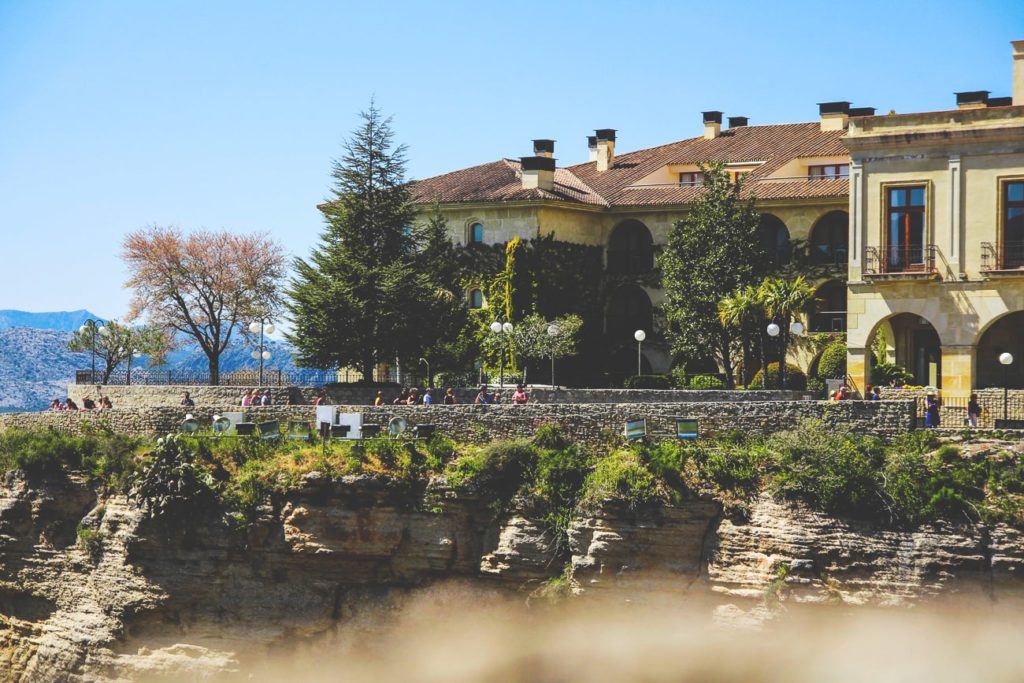
In March, April, and November, it’s already considerably cooler. It also rains more frequently during these months. The advantage, however, is that there are even fewer tourists in the city. You should avoid a trip to Ronda in July and August. Temperatures often climb above 30 degrees Celsius. It’s also the holidays, and prices also skyrocket. You should also expect to see a lot of tour buses and tour groups. Ronda’s true charm is lost at these times.
Summary: The best time to travel to Ronda is in April, May, June, September, and October. Avoid the peak season from July to the end of August.
4. Accommodation in Ronda
If you want to stay overnight in Ronda, you’ll find plenty of lovely accommodations in the city. Starting at €40, you can get a nice double room in a well-reviewed hotel, such as the Hotel San Cayetano. You’ll also find what you’re looking for on Airbnb. Here you’ll find mainly private rooms, houses, apartments, and guesthouses. We’ve been using Airbnb for over 5 years and are very satisfied.
During peak season, you should book your accommodation well in advance. While there are many accommodation options, there are also a lot of tourists at this time. It’s best to book your accommodation right in the center of Ronda. This way, you can explore the area on foot without having to drive into the center.
Accommodation in Ronda:
- Hotel San Francisco*
- Hotel San Cayetano*
- Ronda Hotel Polo*
- Hotel Sevilla*
- Catalonia Reina Victoria*
- Parador de Ronda*
5. Sights in Ronda
You can easily explore Ronda on foot. It’s simply fun to stroll through the beautiful old town, relax in a café, and discover the wonderful highlights and sights of Ronda. Unless you’re there during peak season (July, August), the city’s streets should be relatively relaxed. In the following section, we’ll take you through the beautiful city of Ronda.
The Puente Nuevo Bridge
The city’s main attraction is the “New Bridge.” It connects the old and new towns and crosses the deep El Tajo Gorge. From here, you have a fantastic view of the Sierra de Grazalema mountain range and the many white houses built directly onto the hills.

The bridge was built in the 18th century as a stone bridge with three archways and is one of three bridges over the gorge. You can get a great view of the bridge from further down. To get there, simply stroll over the bridge toward Casa don Bosco. On the way there, a path branches off, leading down into the gorge.
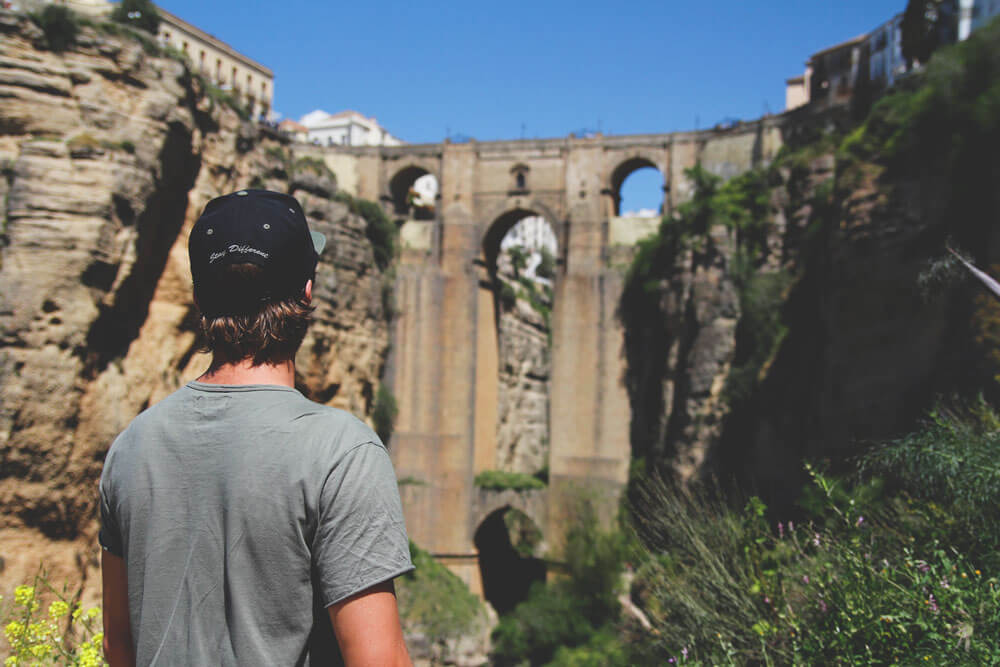
The El Tajo Gorge
Under the bridge lies the El Tajo Gorge. But actually, the whole of Ronda is surrounded by this gorge. From the city walls, you have a fantastic view of the small river and the gorge. It’s a particularly great photo opportunity in spring. Then you can see the many bright green trees, shrubs, and colorful flowers in full bloom.
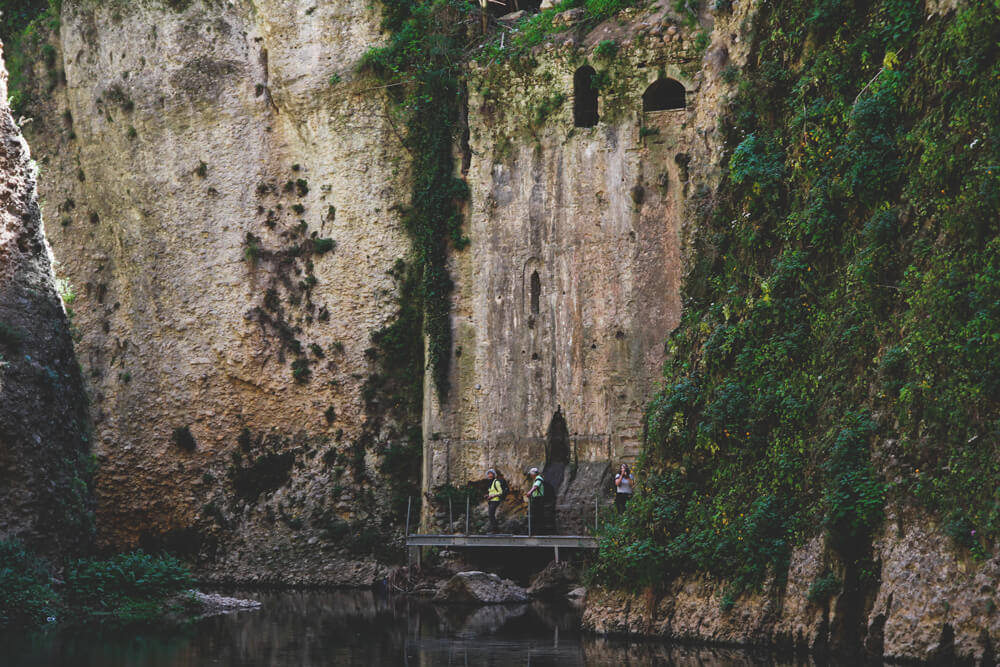
A beautiful waterfall plunges into the depths beneath the Puente Nuevo. You can climb down and walk under the bridge. You can enjoy further great views of the gorge from the other bridges, from the former town hall, and from the hanging gardens of Forestier.
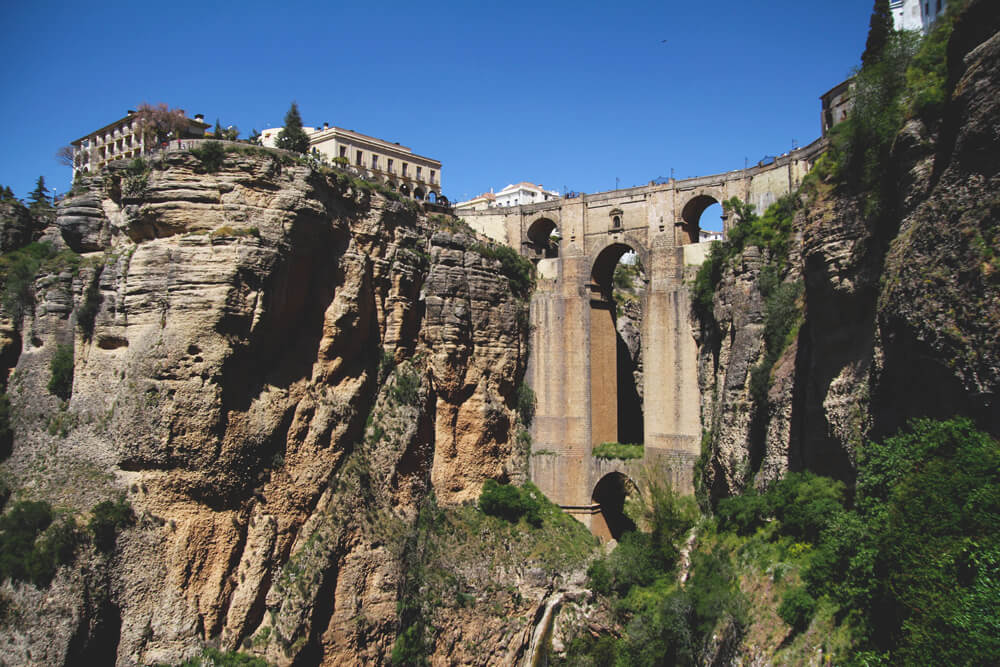
The Palace of Mondragon
Another highlight in Ronda is the Palace of Mondragon. It is an impressive building from the Islamic period. The appearance of this palace has changed several times. Nevertheless, the beauty of this The building’s many details still stand out today. The palace is now a museum and showcases the natural areas of the Serranía de Ronda. The gardens and courtyard, with their marble columns and mosaics, are particularly beautiful. The museum is open Monday to Friday between 10 a.m. and 6 p.m. On Saturdays and Sundays, the palace is open from 10 a.m. to 3 p.m.
The beautiful old town “Ciudad Vieja”
The old town in Ronda is truly pretty. It has beautiful little streets with charming white houses, many cafés and restaurants, and often a car-free zone, as the streets are too narrow for cars. Although Ronda is generally very touristy with many tour groups from all directions, it’s still worth a trip.
Away from the groups, the spark ignites, and you can fully enjoy the beauty of the city. We turned directly into the side streets and had some of the alleys completely to ourselves. Most tourists only stop at the main attractions.

Shopping in Ronda on the Carrera Espinel
Ronda in Andalusia not only has a beautiful old town, but also a popular pedestrian street for shopping. The Carrera Espinel runs directly through Ronda and is home to small shops, restaurants, cafés, and charming stores. Outside of peak season, this street is quite pleasant. However, if you travel to Ronda in midsummer, you’ll be sharing this part of town with countless other tourists.
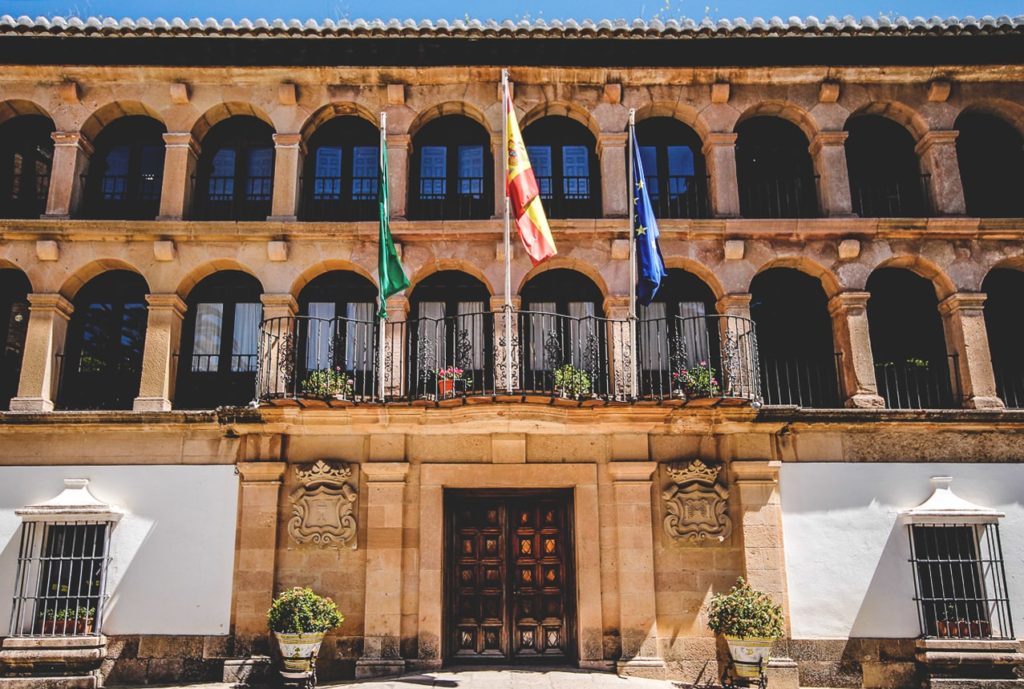
The beautiful Alameda city park
You’ll find peace and serenity in the Parque Alameda. This is located in the newer part of Ronda and is home to the famous viewing platforms, the historic Real Maestranza de Ronda, and the nearby bullring. You can put your feet up and take a breather on one of the many benches. At the edge of the gorge, you’ll find the Mirador de Ronda, one of the most beautiful viewpoints over the gorge.

The Plaza de Torro Bullring
The bullring in Ronda was one of the first in all of Spain. If you walk toward Plaza de España, after 100 meters, you’ll reach Plaza de Torro. Here, in the arena, new rules were established, such as the torero’s fight on foot and the use of a red cloth.

You can visit the arena and the associated museum from November to February between 10 a.m. and 6 p.m., from April to September between 10 a.m. and 8 p.m., and from October to March between 10 a.m. and 7 p.m. If a bullfight is taking place, you cannot enter the arena or the museum. Unless you are watching the bullfight. The entrance fee is currently €7 per person.
The Arab Baths of Ronda
Some of the best-preserved Arab baths in Spain can be found in Ronda. They were built at the end of the 13th century during the reign of King Abomelik. You can find them in the city’s Islamic quarter of San Miguel. The arches and glazed light openings are particularly impressive. The baths were once built from sandstone and brick and still illustrate the unique bathing culture of the Islamic period.
The Arab Baths are open in autumn and winter between 10 a.m. and 6 p.m. On Saturdays, Sundays, and public holidays, only from 10 a.m. to 3 p.m. In spring and summer, the baths are open from 10 a.m. to 7 p.m. On Saturdays, Sundays, and public holidays, also from 10 a.m. to 3 p.m. The entrance fee is currently €3.50 per person.
The beautiful Church of Santa Maria la Mayor
Ronda is not only home to viewpoints, a bullring, and a shopping mile. A visit to the Church of Santa Maria la Mayor is also recommended. This very old church is located on the Town Hall Square. Nobody knows exactly how old the church really is. The Santa Maria la Mayor was once a mosque before it was unfortunately destroyed by an earthquake in the 16th century. But thanks to reconstruction, you can still admire this church today.
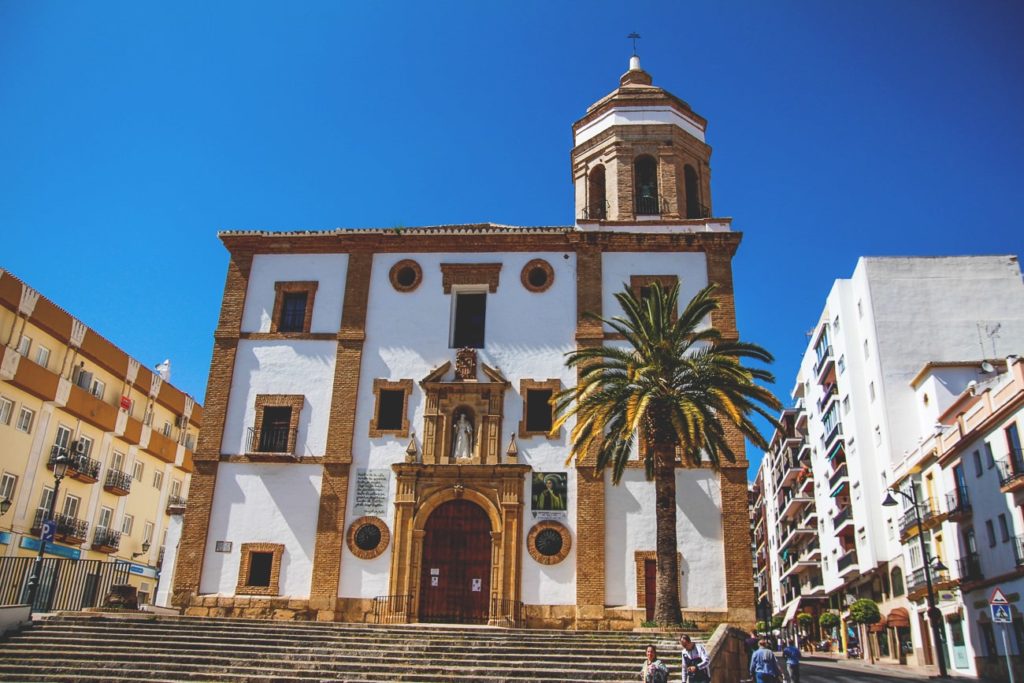
The church is open Monday to Saturday from 10 a.m. to 7 p.m. On holidays and Sundays, the church is open from 10 a.m. to 12:30 p.m. and, after a break, again from 2 p.m. to 7 p.m. The entrance fee is currently €4 per person. However, admission is free for children.
The Jardines De Cuenca Gardens
From the New Bridge, you can see Ronda’s next little highlight: the beautifully landscaped Jardines de Cuenca. A relaxing pedestrian path runs through here. Just head towards the “Hanging Gardens of Forestier.” These are located in the Casa del Rey Moro (“House of the Moorish King).” Entrance costs €5, and from there you can take the stairs down to the gorge. If you want to save the money, just walk past it and continue to the Puente Viejo bridge. From here you can stroll through the Jardins de Cuenca.

Dreamlike view – Castillo del Aguila
On our way back to Tarifa, we accidentally spotted a castle (“Eagle Castle”) in the mountains from a distance. Without further ado, we turned off and headed there. Although the castle was closed, we found a path up onto the rocks on the side. From there, we had a stunning and unique view of the landscape – you could even see Africa on the horizon. Incredible! If you’re nearby, be sure to stop here. It’s worth it!

Our Culinary Highlight – 100 Montaditos
We don’t often write about food, as we don’t usually find our dishes particularly exciting. We also don’t want to be waving our cameras around our food in restaurants or anywhere else. But we don’t want to deprive you of our Spanish favorite. We already knew this shop from Seville and Barcelona, and there are also “100 Montaditos” in Ronda.

Here you can get lots of small baguettes for just €1. You write down all the varieties you want to order from the menu on a piece of paper. A few minutes later, you can pick up your order. Whether with pesto, mozzarella, cream cheese, fish, chicken, or BBQ – the different variations taste truly delicious. Give it a try!
6. Our conclusion about Ronda in Andalusia
Ronda is definitely worth recommending, in our opinion. The trip was well worth it. For us, it was more than worth it. We particularly liked the beautiful architecture, the great buildings, and the unique scenery. Even the journey into the city is promising.
It’s not uncommon to hop out of the car to take a photo along the way. A day trip to Ronda is perfectly sufficient to explore the city. However, if you want to enjoy the stunning scenery for a few more days, you can also stay one or two nights there. If you’re taking a tour of Andalusia, Ronda should definitely be on your list.